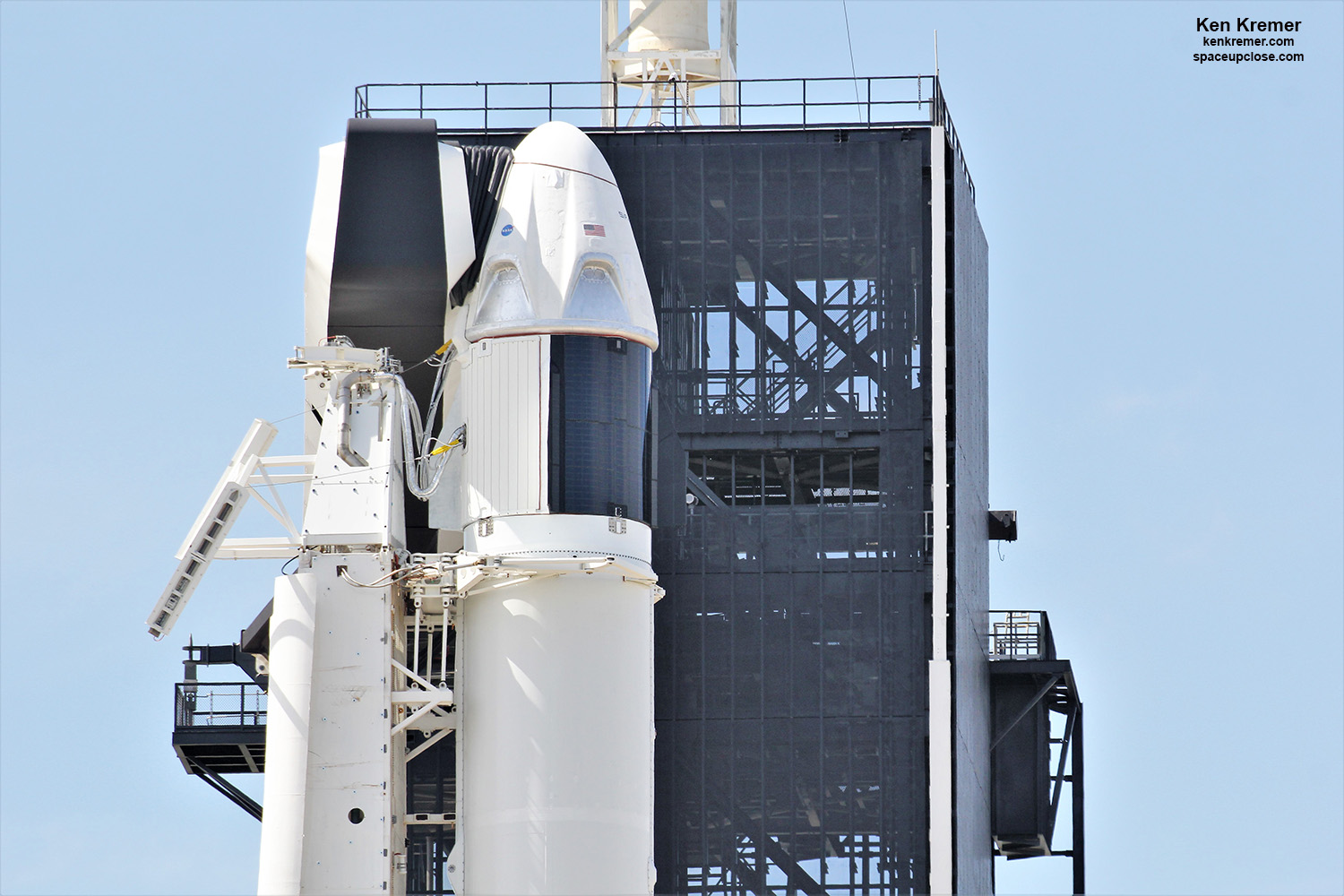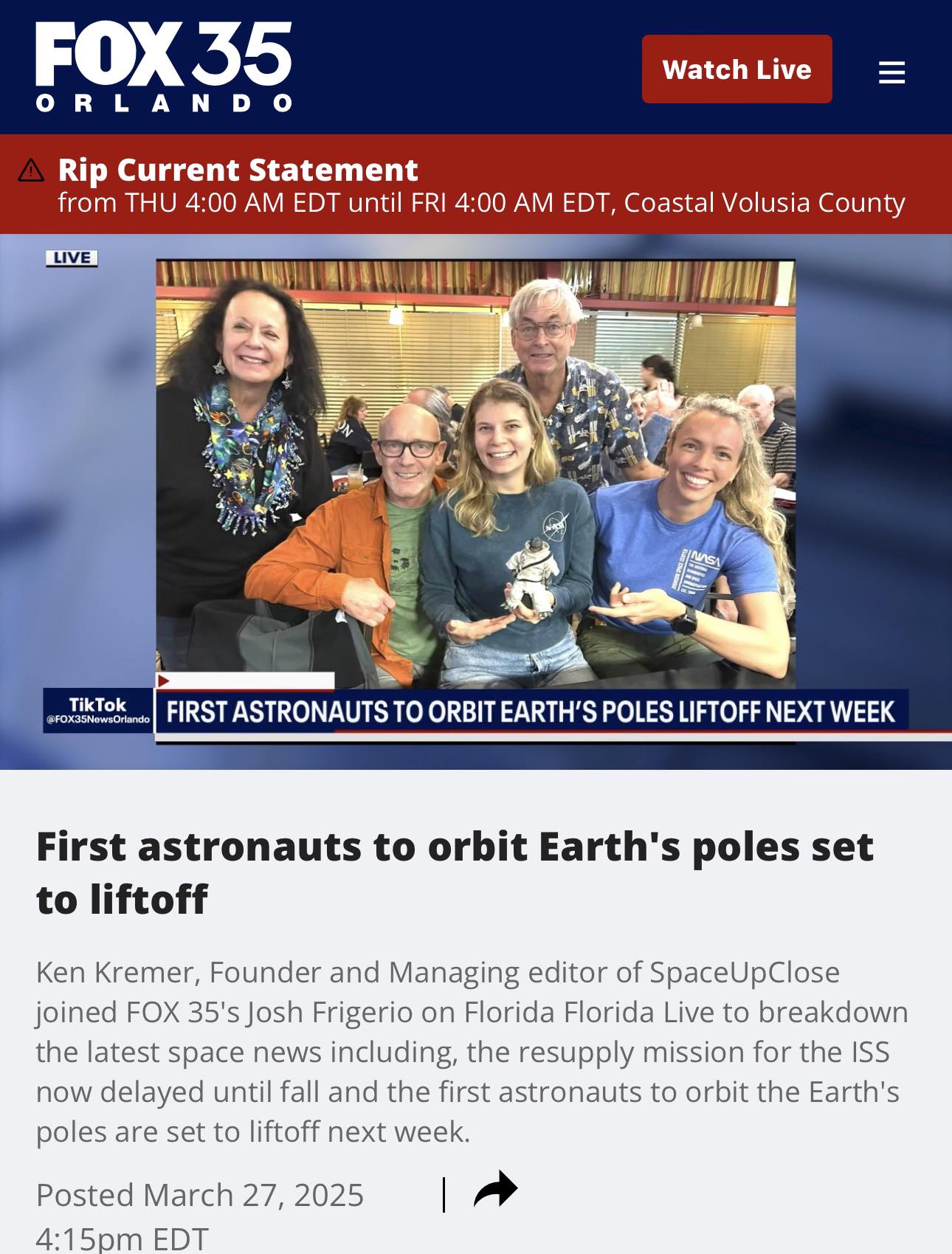
CAPE CANAVERAL, FL – The key spaceflight test hardware required for SpaceX’s next step to eventually launch NASA astronauts to the International Space Station (ISS) as part of the agency’s Commercial Crew Program – namely for the Crew Dragon In-Flight abort test – has arrived at last at the Kennedy Space Center (KSC) in Florida.
The human-rated SpaceX Crew Dragon test vehicle and the Falcon 9 rocket that will propel it on the so called ‘In-Flight Abort’ (IFA) test were shipped to SpaceX processing facilities at the Kennedy Space Center and Cape Canaveral, Florida.
“The @SpaceX Falcon 9 and #CrewDragon spacecraft that will be used in the In-Flight abort test have arrived at SpaceX facilities in Cape Canaveral, Fla., for preparation ahead of the test!” NASA tweeted on Oct. 3.
The In Flight Abort test is a critical test hurdle SpaceX must successfully pass to prove that a Crew Dragon spacecraft will be pulled away safely in a split second in case of a catastrophic failure of the Falcon 9 rocket in flight and save the astronauts lives using the Super Draco abort engines mounted on the side wall of the spaceship Crew Dragon – before NASA will permit its astronauts to be launched.
A date for the ‘In-Flight Abort’ (IFA) test has not yet been announced by NASA or SpaceX – but there are indications the launch will take place before the end of this year.
In a recent interview last weekend with CNN, SpaceX CEO and founder Elon Musk said the test hardware would arrive soon at the Cape and the launch could take place as soon as the November time frame.
The SpaceX team is now preparing both pieces of hardware for the upcoming launch.

The Falcon 9 first stage is recycled from a previous launch.
The Crew Dragon will be the Demo-2 model originally intended to be used for the first astronaut crew launch on the Demo-2 test flight to the ISS.
Initially SpaceX planned to reuse the Demo-1 Crew Dragon successfully launched to the ISS on an unpiloted test flight earlier this year in March.
SpaceX engineers had been preparing Demo-1 for the critical IFA test in hopes of paving the path for eventual human missions starting with the Demo-2 Crew Dragon later this year.

At that time the IFA test had been slated for July 2019 following by the Demo-2 test flight with two NASA astronauts launching sometime in the Fall.
Two NASA astronauts Bob Behnken and Doug Hurley will fly aboard the Demo-2 Crew Dragon whenever it does launch.
But that entire schedule was thrown into disarray and delayed indefinitely when the Demo-1 Crew Dragon was suddenly destroyed in a catastrophic accident a month later on Easter Sunday April 20 – when the very same Super Draco abort thruster engines intended to save the astronauts during a launch emergency instead exploded while undergoing static fire ground testing on a test stand at Cape Canaveral Air Force Station.
The devastating explosion at Landing Zone-1 (LZ-1) resulted in the total destruction of the Demo-1 Crew Dragon commercial spaceship.
Thus it had to be replaced in order to carry out the InFlight Abort test and SpaceX decided to replace the Demo-1 capsule and has “shifted spacecraft assignments.”
“With multiple Crew Dragon vehicles in various stages of production and testing, SpaceX has shifted the spacecraft assignments forward to stay on track for Commercial Crew Program flights,” explained Hans Koenigsmann, SpaceX’s Vice President of build and flight reliability at a media briefing at KSC this past summer.
“The Crew Dragon spacecraft originally assigned to SpaceX’s second demonstration mission to the International Space Station (Demo-2) will carry out the company’s In-Flight Abort test, and the spacecraft originally assigned to the first operational mission (Crew-1) will launch as part of Demo-2,” Koenigsmann confirmed.
Thus SpaceX has decided to use the Crew Dragon vehicle previously planned for use on the Demo-2 crew mission to the ISS for use on the IFA test.

The failed April test thus delays the inaugural astronaut launch on the SpaceX Demo 2 mission previously planned for this fall from Launch Complex 39A at NASA’s Kennedy Space Center until sometime early next year – 2020.
In the CNN interview, Musk said the Demo-2 test flight could take place perhaps “in three or four months” depending on what NASA decides and the outcome of the IFA test.
Separately NASA Administrator Jim Bridenstine told CNN that the first piloted Crew Dragon test flight was “months away.”
Furthermore in a Sept. 27 twitter critique, Bridenstine said he expects SpaceX to devote the same level of commitment to Commercial Crew that’s “years behind schedule” as he is to the Sept 28. starship announcement:

The in-flight abort test will demonstrate whether the capsule can survive an abort of the Falcon 9 rocket through “one of the harshest moments of launch: max Q, or maximum aerodynamic pressure.”
At about 1 minute into flight SpaceX engineers will intentionally trigger an abort when the Falcon 9 and Crew Dragon reach Max Q.
Altogether there are 8 SuperDracos ringing the Crew Dragon that produce up to 16,000 pounds of thrust and are designed to restart multiple times as needed in an emergency.
It is expected that the Falcon 9 will disintegrate from harsh aerodynamic forces from the simulated launch emergency – while Crew Dragon pulls away via the 8 SuperDracos, deploys parachutes and safely splashes down in the Atlantic Ocean. Recovery crews will retrieve it from the ocean waters soon thereafter.
Here is NASA’s description of the IFA test:
“As a rocket-and spacecraft ascend there is a combination of speed and air density, which adds up to the maximum pressure on the vehicle approximately one minute into flight. It is at this point that an abort would be the most difficult. At this instant during the test, SpaceX will intentionally send the abort command to the Crew Dragon and Falcon 9. Instantly, the rocket will begin to shut down its engines and the eight SuperDraco engines on the spacecraft will ignite to rapidly accelerate and fly the Crew Dragon away from the rocket. SpaceX will gain significant data from this test to validate their design and models.”

The commercial Crew Dragon vehicle is being developed under a contract awarded to SpaceX by NASA back in 2014 valued at more than $3.1 Billion with the goal of restoring US human spaceflight capabilities in a safe, reliable and cost effective manner and ending our sole reliance on the Russian Soyuz capsule.
That capability to launch humans to space was lost since the forced retirement of NASA’s Space Shuttle fleet in 2011.

Boeing is also developing the Starliner crew capsule under a similar commercial crew contract with NASA.
Both capsules have suffered repeated delays.
NASA’s final Soyuz contracted seat is set for launch on Spring 2020.




